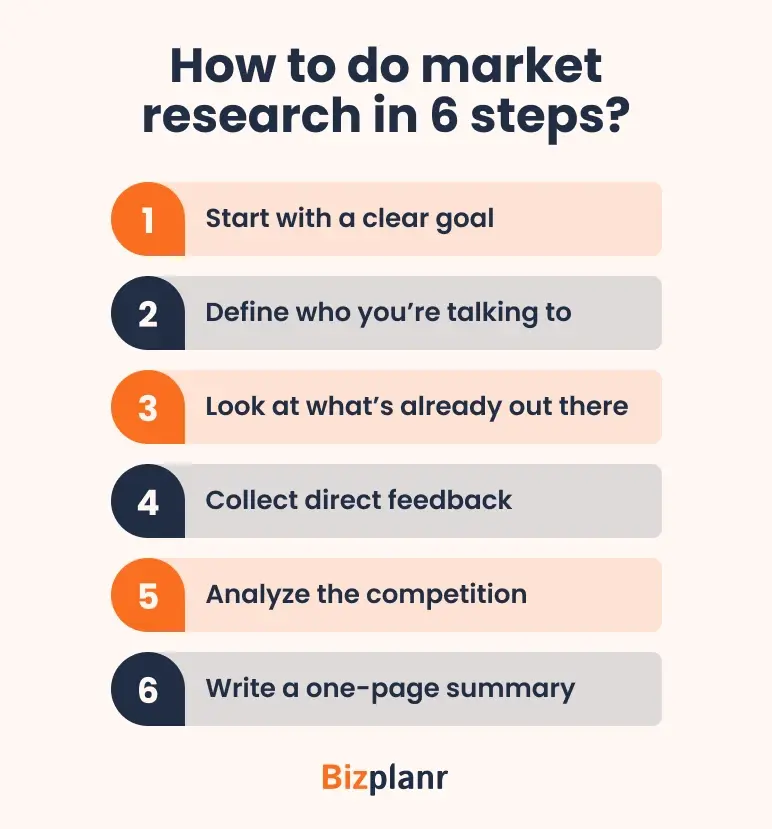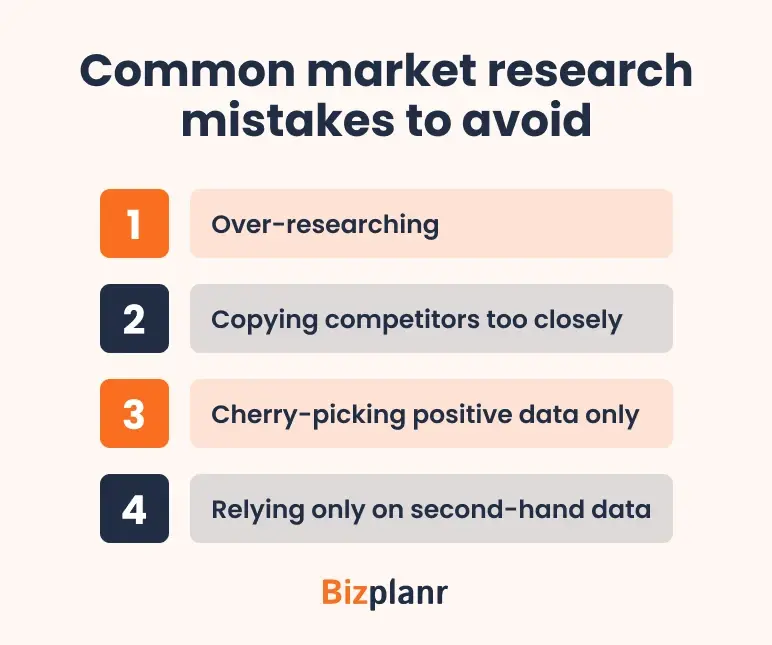My first attempt at market research was when I made an Instagram poll. I had three votes: One “yes,” one “maybe,” and one from a burner account I forgot was mine.
Shockingly, that didn’t translate to product-market fit!
Turns out, if you want real market research data, not just likes from your high school classmate, you’ve got to do it properly. That means talking to actual target customers, asking better questions, checking real demand, and avoiding the trap of cherry-picking nice answers confirming your bias.
This blog breaks down how to conduct market research step by step.
You’ll learn how to combine primary and secondary research, find real insights, and test your business idea without wasting time or money or posting another Instagram poll. 🤐
What is market research?
Market research is the process of gathering information about your target market, your potential customers, and the other businesses already trying to sell to them. It helps you answer questions like: Who are they? What do they need? How much will they pay?
It involves both primary research (like interviews or surveys) and secondary research (like scanning industry reports or doing a competitive analysis). You’re collecting data so you can make smart marketing strategy calls based on facts.
The point is to get actionable insights you can use to build, price, position, or tweak your offer before you spend anything big.
How to conduct market research (quick overview)
Start with secondary research. Pull data from industry reports, trend platforms, and reliable existing data sources. This shows where the market stands, what your target audience responds to, and how your market segment behaves at scale.
Then, switch to primary research. Collect responses through interviews, surveys, or direct product feedback. This fills the gaps with specifics—what your potential customers expect, how they react, and what actually influences their decisions. One sets the context, the other gets the truth.
Combine both the data to get accurate insights. Keep reading, we’re getting into the details next.
What are you trying to figure out with market research?
When you conduct market research, you’re not just collecting random data. You’re asking five very specific questions to understand whether your business idea stands a chance.
Let’s break them down.
| Question | Explanation |
|---|---|
| Who's buying? | Start by defining your target audience. Break it into clear market segments and build buyer personas. Understand demographics, habits, and values. |
| Why are they buying? | Find out what drives them—pain points, needs, goals. Strong customer behavior data reveals what they expect from a product or service. |
| How do they choose? | Study how people evaluate options: reviews, social media platforms, and peer opinions. |
| What do they pay? | Use pricing research and internal data to understand price sensitivity, spending habits, and the limits of your market size. |
| Who else is selling? | Run a proper competitive analysis. Look at competitor strategies, do a clean data analysis, and identify market gaps. |
Answer these five questions properly, and you’ll walk into the market with actual direction.
Types of market research and when to use them
There are two types of market research: the kind where you do the work (primary research) and the kind where you read what’s already been done (secondary research).
Primary market research
Primary research means you collect feedback straight from your target customers. You run the surveys, ask the questions, and do the data collection yourself. It’s the cleanest way to understand what’s happening in your market segment because the answers come directly from the people you want to reach.
Primary market research covers:
1. Interviews
You speak with real people, either one-on-one or remotely, and ask them about their needs, opinions, or reactions to your product or service. Good interviews give you raw, honest insights.
You’ll hear actual language customers use, which helps with messaging later. It works well for understanding buyer personas and their decision-making behavior.
2. Surveys
You build a structured questionnaire and send it to a group that fits your target market. It gives you solid quantitative research and helps identify market trends, price sensitivity, and early signs of customer satisfaction or frustration.
3. Focus groups
You gather a small group of participants and let them discuss or react to ideas. These sessions help uncover emotional drivers, brand perception, and how people influence each other. They’re ideal for exploratory research, though groupthink can sometimes skew results.
4. Product trials or usability testing
You give your product to potential customers and watch how they interact with it. Where do they get stuck? What do they ignore? This type of research bridges the gap between what users say and what they do. It informs data analysis, feature improvements, and customer satisfaction strategies.
5. Buyer persona research
This takes all your interviews, behavioral patterns, and purchase data and turns them into detailed customer profiles. These personas represent specific segments of your target audience and are not just limited to who they are but what they care about, how they decide, and what messaging speaks to them.
6. Market segmentation research
Instead of treating all potential customers the same, this research helps divide them into groups based on traits, behaviors, or needs. You can personalize your marketing campaigns, pricing, and product features with clear market segments.
Did you know?
LEGO used market segmentation research to uncover a major blind spot in their audience: Only 9% of their users were girls. That insight came from targeted market research focused on gender-based play behavior.
Instead of making changes to existing sets, LEGO launched new product lines (like LEGO Friends) designed around how young girls interact with toys, with more storytelling, more color variety, and characters with emotional appeal. It resulted in the expansion of a segment they had barely touched before, grew revenue, and became a brand that spoke to a wider target market.
7. Pricing research
This technique helps you figure out what people are willing to pay. Use it to test tiered plans, anchor prices, or discount structures. It often includes data collection through surveys and trials and plays a key role in shaping your pricing strategy.
8. Customer satisfaction research
This research shows what keeps existing customers loyal and what drives others away. You use this to understand churn risk, find service gaps, and prioritize product fixes. It feeds into retention strategy and long-term planning.
These are some of the major primary research methods. It’s especially useful when launching a new product or service, updating messaging, or testing brand perception.
Secondary market research
Secondary research involves analyzing existing data collected by external sources such as business reports, government publications, competitor research, and academic studies.
9. Competitive analysis research
In this process, businesses examine competitors’ strengths, weaknesses, pricing, and market positioning by using public data, reports, and financial statements.
It helps them find underserved niches and anticipate competitor moves. In every country it enters, McDonald’s studies local food preferences, dietary habits, and pricing expectations. This lets them make changes to menus, adjust marketing, and build offerings that feel local.
10. Brand awareness research
Businesses employ this technique by using existing surveys, social media mentions, and public opinion studies. It measures how well a brand is recognized and perceived in the market by consumers.
11. Campaign research
This process involves analyzing past marketing campaigns, using performance data, and consumer responses to determine what works and replicating successful elements for better ROI.
12. Competitive intelligence research
In this process, businesses track all the market shifts, consumer sentiment, and competitor strategies with the help of industry-based reports, analyst research, and economic forecasts to stay ahead of emerging trends.
13. Google Trends
Here, you keep track of what people search for, when, and where on Google. This helps spot emerging trends, seasonal interest, and shifting demand patterns. It’s free, fast, and surprisingly useful for mapping interest in your product or service.
14. Review sites
Look at what real users say about competing products. You’ll find patterns in praise, complaints, and feature requests. These insights show what your potential customers actually care about without having to ask.
When do primary and secondary research work, and when don’t they?
Primary research gives direct, specific insights from your target customers. You control the questions, adjust them as needed, and collect market research data that no one else has. It’s useful for testing ideas, building buyer personas, and shaping your offer with real input.
But it takes time, and the wrong questions can lead to skewed data. That’s where secondary research helps. You scan industry reports, track market trends, and explore existing data to understand your target market at scale. Start wide with secondary, then dig deeper with interviews and surveys. That mix works.
How to do market research in 6 steps?
You need a clear, simple process that shows you what to do, when to do it, and how each step leads to better decisions.
Step 1: Start with a clear goal
Most research fails before it starts because there’s no defined purpose. So, before you collect anything, decide exactly what you want to learn. Maybe you want to understand your market size, test a pricing strategy, or validate whether your target market even cares about what you're offering.
You don’t need a 10-page research plan. One solid sentence works: “I want to find out if busy professionals in urban areas are open to paying monthly for a done-for-you meal prep service.”
That level of focus keeps your research efforts tight, your questions useful, and your data relevant to actual business decisions.
Step 2: Define who you’re talking to
You can’t collect meaningful data if you don’t know who the right people are. Get specific. Build a clear profile: age group, habits, location, pain points, and how your product or service fits in. If you’re testing something hyper-local, talk to locals.
If you're launching software, talk to early adopters. The more relevant your target audience, the sharper your results. This early-stage customer analysis sharpens your outreach and helps frame the right questions during interviews and surveys.
This step shapes everything: Survey responses, interviews, and which platforms you use for outreach.
Step 3: Look at what’s already out there
Now, it's time for secondary research. Start with industry analysis and public data to see what trends are already visible. What’s the general market size? What’s happening in your market segment? Who are the dominant players?
Don’t stop at the obvious sources. Scan social media platforms, product review sites, customer forums, and even town or city business data. Look for early indicators, repeated complaints, or overlooked needs.
You’ll spot patterns: “People love the convenience but hate the pricing,” or “There’s demand, but no one serves mid-range customers.” That gives you a base to test later with primary research.
Step 4: Collect direct feedback
Conduct primary research. Run a survey. Do interviews. Use short tests, product demos, or even focus groups if you want group discussion. But don’t fall into the trap of “Do you like this?” questions. Ask about their current habits, problems, and what they’ve tried so far.
A good question like “How do you currently solve [X]?” or “What’s the hardest part of [Y]?”—this gets you real feedback. If you're testing an idea, give them a mock-up or rough version. Watch how they react, what they say, and what they don’t say. This step gives you the raw insights that no secondary data can match.
Step 5: Analyze the competition
You skimmed the competitive landscape in step 3, so now you go deeper. Choose 3 to 5 close competitors and break them down. What’s their positioning? What do their reviews say? Where do they win, and where do they lose customers?
Look at their pricing, delivery model, branding, and customer loyalty indicators like repeat purchases or active communities. Tools like review scrapers, public traffic estimates, or side-by-side offer tables help.
Your job here is to find gaps, overlaps, and areas where your product or service fits without getting buried. A structured competitive analysis here helps you spot market gaps and avoid blending in with similar offers.
This could even feed into a basic SWOT analysis if you want to map out your strengths and weaknesses compared to the rest.
Step 6: Write a one-page summary
At this point, you’ve got a stack of notes, quotes, and feedback. You could turn all this into a 15-page doc no one asked for. Or you could be smart and write a one-page summary with:
- Who is your target market
- What you learned about their needs
- Trends you observed
- Strengths and weaknesses of competitors
- How your product or service solves a real problem better or differently
- Any useful data that backs up your business decisions, like highlights from your market analysis
This keeps your insights in one place and your next steps aligned with what the research actually shows. If you want to skip the formatting and focus on the insights, use a free market research template to plug everything in quickly.
You’ve now seen how to conduct market research in a structured way. You might collect insights through surveys, run a few interviews, or host focus groups, but the core steps for effective market research stay the same. But even the best process fails if the data behind it isn’t genuine.
So, the next part is about making sure the research you’ve done is actually useful and not built on outdated sources, weak inputs, or irrelevant data.
Ensuring authentic & accurate market research data
Just because you’ve finished your market research doesn’t mean every number or quote is worth trusting. Before you base real decisions on shaky input, double-check that your data holds up.
Is it from the last 12 months? That’s step one. If your source is old, say, from five years ago, it doesn’t show the current state of your market. Industry trends change, and customer behavior shifts, so your target market today may not act the way it did even a year ago.
That’s especially true if you’re basing your decisions on feedback from existing customers or planning for a space with fast-moving market dynamics.
Was it collected by a real source? Reliable insights usually come from structured surveys, one-on-one interviews, or well-run focus groups. If your data came from a forum post or a few random tweets, it’s not good enough.
In qualitative research, the context behind the answer often matters more than the answer itself. That’s why using trusted methods is part of doing effective market research.
Are you ignoring things that don’t fit your idea? One of the biggest mistakes people make when they conduct market research is filtering out anything that doesn’t support their original plan. That’s called confirmation bias, and it kills good strategy.
Real feedback includes opinions you didn’t predict. If something doesn’t match your expectations, take a second look. Those details often reveal blind spots about your target market that you wouldn’t catch otherwise.
Did you ask questions that let people answer freely?
Reliable data is the foundation of any research worth using. When your inputs are accurate, you get more than just numbers. You get clarity. Your competitor analysis becomes sharper because you’re working with facts, not outdated assumptions.
It also makes your strategy stronger. Clean data helps you avoid detours. You won’t waste time chasing the wrong target market or building features based on what a few biased survey answers suggested.
How can AI help?
AI doesn’t replace smart thinking. It just speeds things up. Using Perplexity or ChatGPT for market research, for example, helps you get through the messier parts of research without cutting corners.
Here’s how they help:
- Draft survey or interview questions that feel natural and don’t lead the respondent.
- Summarize long-form reports, competitor pages, or customer reviews so you don’t have to read them line by line.
- Break down feedback from focus groups or open-ended responses into themes you can actually use.
- Spot gaps in your outline, like missing audience segments or unclear prompts.
- Turn unstructured notes into clean summaries that support your one-page findings.
- Compare competitor messaging, pricing, and positioning faster, especially across multiple sources.
- Generate quick drafts of your research summary so you’re not starting from a blank screen.
Use AI to support your workflow, not replace it. The thinking still comes from you. But when used right, it makes conducting market research faster, neater, and less manual.
Common market research mistakes to avoid
Even when your research plan looks fine on paper, execution is as important. Here’s where things often go wrong.
Over-researching
You don’t need a hundred pages of notes to understand your target market. At some point, more data just makes things noisier. Stop when the insights start repeating themselves. That’s usually a sign you’ve got enough to move forward.
Copying competitors too closely
Studying competitors helps, but copying them doesn’t. If you mirror what others do in terms of pricing, features, and positioning, and stop thinking critically about your own product or service, you’ll likely miss what makes yours valuable. The goal of market research is to find your edge.
Cherry-picking positive data only
It’s tempting to highlight only the feedback that supports your idea. Don’t. Ignoring uncomfortable responses leads to incorrect data and weak decisions. Listen to what you didn’t want to hear. That’s usually where the key insights are.
Relying only on second-hand data
Secondary research gives you context, but you still need direct input from your target customers. If you never conduct primary research, you’ll miss the important details, like how people describe their needs or why they choose one solution over another.
Conclusion
Good market research doesn’t just tell you what people want. It helps you figure out what not to build, what to stop assuming, and where you’re wasting time.
Most of the risks in a new business come from acting without knowing. Research lowers that risk, not by being perfect, but by giving you enough valuable insights to move with direction instead of hope.
And once you've done the work of gathering information, don’t let it sit in a folder. Build from it. Bizplanr helps with that part, taking what you’ve learned and turning it into something structured and useful for your next steps.
No one gets it all right up front. But with clear thinking and research that actually reflects your target market, you’ll be way ahead of most.
Get Your Business Plan Ready In Minutes
Answer a few questions, and AI will generate a detailed business plan.
Frequently Asked Questions
How long should market research take for a small business or startup?
It depends on how much clarity you already have. If you're starting from scratch, a focused research process can take anywhere from a few days to a few weeks. If you find yourself researching for weeks without new insights, you're probably overdoing it.
What’s the minimum amount of research I need before launching?
Enough to answer the basics: Who are you selling to? What problem are you solving? Why would someone choose your product or service over another? If you can’t answer those with confidence and some form of real data, you’re launching blind.
Can I do market research with no budget?
Yes. You can run surveys using free tools, talk to people in your target market, moderate simple focus groups, or review competitor feedback online. Plenty of useful market research happens without spending a dime; you just trade time for money.
Do I need to hire a research firm?
For most small businesses, no. Unless you're entering a complex or heavily regulated space, you can conduct market research yourself. Save the market research services for when you have scale, funding, or extremely high stakes.
How do I know when to stop researching and start building?
When your answers stop changing. Once you’ve spoken to enough people, reviewed your competitors, and spotted consistent patterns, it’s usually time to move forward.







